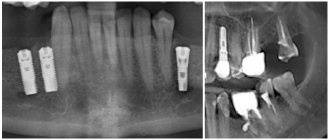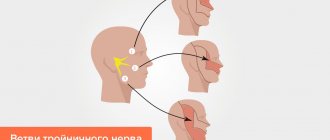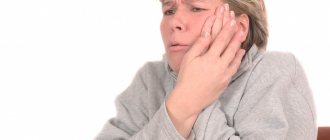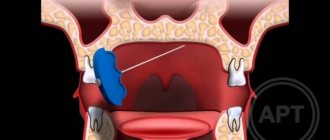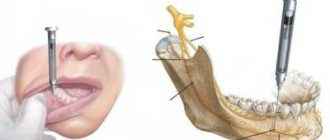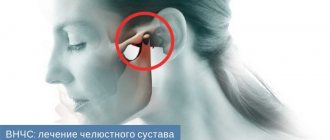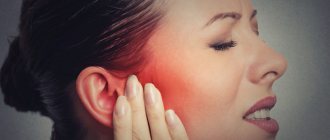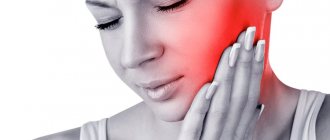What is mandibular nerve injury?
By this concept, dentists mean injury to one of the nerves:
- chin;
- lingual;
- alveolar.
Types of injuries include sprain, compression, crushing and rupture - partial or complete. The cause of the stretching is the long-term retraction of the mucoperiosteal flap, which is created by an implant of greater length than necessary. Crush injuries and compression are caused by needle injuries during the administration of anesthesia. Rupture occurs in two cases: when cutting the mucosa or during preparation of the hole for the implant.
Causes and prevention of mandibular nerve injuries
The only cause of such damage is considered to be medical errors. Since in preparation for implantation, X-rays of the jaw are taken, which the doctor must carefully study so that when choosing an implant and a place for it, he does not injure the nerve, the injuries are caused by his unprofessionalism or negligence.
Damage to the mandibular nerve most often occurs when:
- improper administration of anesthesia - needle injury;
- choosing an implant that is too long;
- damage by an instrument - when preparing the site for the implant.
The only way to avoid such an injury is for a doctor to responsibly approach the stage of preparation for surgery, carefully studying the condition and structure of his patient’s jaw. The only way of prevention for the patient is to choose a trusted clinic and a highly qualified doctor. Specialists at the Implantmaster clinic have been able to reduce the number of injuries of this kind to 2%, since they carefully study three-dimensional photographs of a person’s jaw before implantation, and can correctly assess the condition of the bone tissue, the location of nerves and blood vessels, and select the optimal size of the implant.
Our team of doctors
Maxillofacial surgeon, Implantologist
Bocharov Maxim Viktorovich
Experience: 11 years
Dental surgeon, Implantologist
Chernov Dmitry Anatolievich
Experience: 29 years
Orthopedist, Neuromuscular dentist
Stepanov Andrey Vasilievich
Experience: 22 years
Endodontist, Therapist
Skalet Yana Alexandrovna
Experience: 22 years
Orthopedic dentist
Tsoi Sergey Konstantinovich
Experience: 19 years
Dentist-orthodontist
Enikeeva Anna Stanislavovna
Experience: 3 years
What are the symptoms of the disease?
Symptoms of glossopharyngeal neurosis are characterized by the appearance of pain in the tonsils or root of the tongue, radiating to the throat, ear, palate, and less often to the neck and eyes. The average duration of pain attacks is 2 minutes. It is localized on the right side of the tongue, that is, it is one-sided. The main symptom of the disease, as with any other type of neuralgia, is severe pain. Sometimes patients complain of dry mouth during an attack.
In medicine, trigger zones are also identified, the irritation of which can cause an attack (palatine tonsils, arches). The disease can also be accompanied by a cough, decreased blood pressure, increased salivation, taste disturbances (a person thinks that everything is bitter), and the aggravation occurs in the autumn-winter period. All symptoms are individual and depend on the cause of neuralgia.
Effective treatment of the disease
If you suffer from neuralgia of the glossopharyngeal nerve, then contact us, where highly qualified neurologists with extensive experience will conduct a full examination, identify the causes of the disease and prescribe comprehensive treatment.
Our clinic is open every day, including weekends and holidays. The appointment is by appointment, you will not need to stand in line and spend a lot of time to get to the neurologist.
Treatment of this type of neuralgia takes place comprehensively after differential diagnosis. The doctor may prescribe an orthopantomogram - an x-ray of the upper and lower jaw. This will enable the doctor to identify enlargements of the styloid process. If it is normal, then a computer and/or magnetic resonance imaging of the brain is done, where the presence or absence of tumors, aneurysms, and skull injuries will be seen. Additionally, electroneuromyography is performed, which records nerve impulse disorders.
After the diagnosis is made, adequate treatment is prescribed - this can be surgical intervention, when during the operation the glossopharyngeal nerve is freed from compression by tissues. The doctor performs microvascular decompression of the nerve or resection of the styloid process, depending on the indications. During the operation, special endoscopic equipment is used, which makes it possible to cause fewer injuries and increase the success of the operation.
In addition to surgical intervention, physiotherapy and drug treatment are also used, in which a number of analgesics, antipsychotics and other drugs are prescribed.
Remember that glossopharyngeal neuralgia is treatable, and this can be done in our medical center!
Doctor's advice
Treatment of the disease is long, sometimes it takes 2-3 years until complete recovery, so be patient and follow all the doctor’s orders. In most cases, the disease appears regardless of the patient, that is, there is no prevention as such. The only thing that can be done is to avoid injuries to the jaw and head, and also not to trigger viral and infectious diseases.
| Make an appointment | Make an appointment by calling +7 (812) 600-67-67 or filling out the online form - the administrator will contact you to confirm your appointment |
UNION CLINIC guarantees complete confidentiality of your request.
Symptoms and stages of damage
The symptoms by which this complication can be recognized are as follows:
- numbness of parts of the head - tongue, lips, chin, cheeks, etc.;
- biting lips and tongue;
- choking while eating or drinking;
- profuse salivation.
All this creates a number of inconveniences for the patient: it makes it difficult to eat and talk, disrupts facial expressions, and also prevents men from shaving and women from applying makeup. The severity of this injury is determined by its degree: a minor one goes away on its own or with the help of drug treatment, a severe one leads to irreversible processes of nerve degeneration and is not curable. Damage to the mandibular nerve, the symptoms of which the patient observes, requires immediate consultation with a doctor - only a specialist will be able to determine its extent and provide timely assistance.
Dentists distinguish the following stages of this implantation complication:
- minor - neuropraxia;
- more severe, but partial damage - axonotmesis;
- a serious injury that leads to complete loss of sensitivity - neurotmesis.
Clinical anatomy of the mandibular nerve
Knowledge of modern methods of conservative and surgical treatment of peripheral branches of n. trigeminus are relevant for doctors of various specialties. This knowledge makes it possible to carry out complex and multidisciplinary treatment of pathologies of the mandibular nerve with good long-term results.
Key words: mandibular nerve, trigeminal nerve, neuralgia, literature review.
Purpose: To conduct a theoretical analysis of modern methods of treating the mandibular nerve based on a review of modern literature.
Research methodology: Theoretical analysis. Review and analysis of literary sources on this issue for the period from 2000 to 2022.
The mandibular nerve (n. mandibularis) is the 3rd branch of the trigeminal nerve and is a mixed nerve. The nerve emerges from the foramen ovale and divides into motor and sensory branches.
Disorders in the trigeminal nerve system can be localized throughout all peripheral branches, as well as in the middle cranial fossa or in the central nervous system [1,2]:
- Peripheral branches may be damaged due to head trauma and be accompanied by loss of motor and/or sensory components. Herpes Zoster, a virus that causes herpes zoster and chickenpox, often causes neuralgia of the peripheral branches of the trigeminal nerve by invading the trigeminal ganglion.
- The middle cranial fossa can be damaged by a tumor - a meningioma, a schwannoma of the nerve itself, or a schwannoma of the auditory nerve at the junction of the cerebellum with the pons (“cerebellopontine angle syndrome”)
- In the central nervous system - demyelinating diseases (multiple sclerosis), vascular disorders and tumors:
a) Localization of the pathological process in the medulla oblongata will lead to loss of pain and temperature sensitivity
b) When the process is localized in the bridge, the path of discriminatory sensitivity, the innervation of the masticatory muscles of the corresponding side, is affected due to damage to the lower motor neurons
c) At a level above the brain stem, the transmission of all types of sensitivity on the opposite side of the head is disrupted, but motor function is preserved, because the motor nucleus is reflexively regulated by sensory impulses and receives bilateral innervation from the cerebral hemispheres.
Research results:
The most common cause of damage to the mandibular nerve is trauma to the maxillofacial area. According to the severity of the damage, according to the classification of traumatic damage to the peripheral branches of the trigeminal nerve according to I.O. Pokhodenko-Chudakova, E.A. Avdeeva and K.V. Vilkitskaya (2013), can be divided into:
1) Mild severity - short-term compression of the nerve, electroodontodiagnostics (EDD) less than 40
2) Moderate severity - hemorrhage, swelling around the nerve trunk, EDI - from 40 to 100.
3) Severe severity - prolonged compression, disruption of the integrity of the nerve, EDI - more than 100 [10,11].
The main goal of surgical treatment in this situation is to eliminate the primary factor of traumatic nerve damage—reposition of bone fragments and their fixation are performed [9]. Unfortunately, if not treated in a timely manner, the patient may develop a persistent pain syndrome and, against this background, secondary trigeminal neuralgia may occur. There are also primary or essential trigeminal neuralgia. Drug treatment of trigeminal neuralgia does not differ significantly in comparison with the treatment of other neuralgia of various localizations (vitamin therapy, sedatives), but it is worth noting that for this pathology the use of antiepileptic drugs (carbamazepine, baclofen, etc.) is very effective. [4,5,6,7]
For neuralgia of the mandibular nerve, surgical treatment methods are also used:
1) operations on peripheral branches (transection of the nerve trunk, alcoholization with endoneural administration of 80% ethyl alcohol), but, at the moment, these operations are used very limitedly, most often in elderly patients.
2) Surgery on the trigeminal ganglion or sensory root of the trigeminal nerve (percutaneous streotactic destruction of the trigeminal nerve, microvascular decompression) [3].
Traumatic nerve damage can also be caused by postoperative swelling of the nerve trunk. To avoid such complications, conservative treatment methods are used, which include drug therapy and the use of physiotherapeutic methods of treatment [7].
The mandibular nerve gives off the inferior alveolar nerve, which enters the mandibular canal of the mandible. This peripheral branch is very often injured due to iatrogenic effects due to careless work of the dentist. In this situation, to remove excess filling material or implant, which can injure and have a toxic effect on the nerve in the mandibular canal, LA operations are used. Grigoryantsev (2008), I. O. Pokhodenko-Chudakova and K. V. Vilkitskaya. [9]
Increasing attention is now being paid to microsurgical operations to restore the integrity of the nerve when it is completely or partially ruptured. For reconstruction, autogenous vein grafts, Gore-Tex tubular implants, and autogenous nerve tissue are used. Unfortunately, these methods only lead to positive results in 50% of patients [12,13,14,15].
In complex treatment, the method of transcutaneous electrical neurostimulation (DENS) is increasingly being used. This method is effective and has no side effects. The two most important disadvantages are the development of tolerance of somatosensory receptors to electric current, but this can be prevented by using different modes, and the presence of contraindications. The mechanism of action is the effect of high-amplitude weak voltage and, at the same time, low-frequency electric current, which causes a response in all types of nerve fibers. This technique is effective for peripheral paralysis and paresis of the masticatory muscles. Moreover, due to their atrophy on the affected side, facial asymmetry may occur over time [8,16,17,18].
It is important to note such pathologies with a polymorphic and little-studied etiology, such as glossodynia and glossoalgia. These diseases are characterized by the fact that at the histological level there is no process of inflammation and degenerative changes in the nervous tissue. Conservative treatment is mainly medicinal (vitamin therapy, sedatives) [19].
Conclusion:
The question of effective methods for treating the peripheral branches of the trigeminal nerve still remains open and is quite acute in view of the polymorphism and implicitness of the etiological factors of the pathology. Conservative treatment, in the vast majority of cases, only leads to relief of symptoms, and the effectiveness of surgical treatment is inversely proportional to its radicality.
Literature:
- Wilson - Pauwels L., translation, edited by A.A. Skoromets Cranial nerves. Function and dysfunction /L. Wilson - Pauwels. - M.: Publishing house: Panfilova; BINOMIAL. Knowledge Laboratory. 2013. - 272 p.: ill.
- Nikiforov A.S., “Clinical neurology”: textbook / A.S. Nikiforov - volume 1 - M.: Publisher: Medicine. 2002. - 600 p.
- Kulakov A.A. Surgical dentistry and maxillofacial surgery. National leadership: textbook for universities / A.A. Kulakov - M.: GEOTAR - Media, 2010. - 928 p.
- Gusev E.I. Neurology and neurosurgery: a textbook in 2 volumes / E.I. Gusev - M.: GEOTAR - Media, 2015. - 640 p.
- Gusev E.I. Neurology. National leadership: textbook for universities / E.I. Gusev - M.: GEOTAR -Media. 2016.- 1029 pp.
- Burykh M.P. Clinical anatomy of the cerebral part of the head / M.P. Burykh - M: - Caravel, Kharkov. 2002.- 240 p.
- Dudnik A.P. Surgical treatment of diseases and lesions of the peripheral system of the trigeminal nerve using microsurgical techniques: abstract of thesis. dis. — 14.00.21 / A.P. Angelica; — Central Scientific Research Institute of Dentistry. M., 2004. - 22 p.
- Pokhodenko-Chudakova I.O., Avdeeva E.A. Methodology of DiaDENS therapy in the treatment of patients with traumatic damage to the inferior alveolar nerve: instructions for use - M.: Minsk BSMU. 2010. - 8 p.
- Sergeev S.M. Stimulation of post-traumatic regeneration of the peripheral nerve in the diastasis zone: abstract. dis: 14.00.02, 03.00.25 / S. M. Sergeev; Saransk State honey. univ. Saransk, 2009.
- Pokhodenko-Chudakova I.O., Avdeeva E.A. Modern classification of traumatic injuries of the trigeminal nerve system / Pokhodenko-Chudakova I.O., Avdeeva E.A// News of surgery. 2013.- No. 6.
- Pokhodenko-Chudakova I.O., Avdeeva E.A. “Semiotics of cranial nerve injuries” educational and methodological manual / I.O. Pokhodenko-Chudakova, E.A Avdeeva. - M.: Vitebsk: VSMU, 2010. 245 p.
- Surgical treatment of trigeminal neuralgia with no neurovascular compression: A retrospective study and literature review 2022 Dec;58:42-48. doi: 10.1016/j.jocn.2018.10.066. Epub 2018 Oct 24.
- Bennetto L., NK Patel Trigeminal neuralgia and its management: British Medical journal/ Bennetto L., NK Patel, 2007 - 201.
- Bushell MC, AV Apkariam, Melzack's Representation of pain in the brain: Textbook of pain/ Bushell MC, AV Apkariam, Melzack's . 2006. - 124.
- Gary D. Klasser, Henry A. Gremillion and A. Dale Ehrlich, Neuropathic Orofacial Pain, Maxillofacial Surgery, 10.1016/B978-0-7020-6056-4.00101-5, (2017).Crossref
- Henry A. Gremillion, Gary D. Klasser and A. Dale Ehrlich, Orofacial Pain, Maxillofacial Surgery, 10.1016/B978-0-7020-6056-4.00102-7, (2017).
- N. Moreau, W. Dieb, A. Mauborgne, S. Bourgoin, L. Villanueva, M. Pohl and Y. Boucher, Hedgehog Pathway–Mediated Vascular Alterations Following Trigeminal Nerve Injury, Journal of Dental Research, 10.1177/0022034516679395, (2016 ).Crossref
- W. Dieb, N. Moreau, I. Chemla, V. Descroix and Y. Boucher, Neuropathic pain in the orofacial region: The role of pain history. A retrospective study, Journal of Dentistry, Oral and Maxillofacial Surgery, (2017). Crossref
- W. Ceusters, A. Michelotti, K. G. Raphael, J. Durham and R. Ohrbach, Perspectives on next steps in classification of oro-facial pain - part 1: role of ontology, Journal of Oral Rehabilitation, (2015). Wiley Online Library Crossref
Recovery and treatment
In the first case, self-recovery takes approximately 1 month; the help of doctors is not needed, since there is no anatomical damage. Symptoms of the second appear after a while - usually 6-8 weeks, so recovery can be painful and incomplete: it will take more than 2 months. In the third stage of damage to the mandibular nerve, treatment gives results only at the beginning and is performed surgically, since we are talking about degeneration with a violation of integrity. Loss of sensitivity, which is observed in a patient for more than 3 months, indicates a high probability of losing it forever. Damage to the mandibular nerve, the consequences of which is the lack of sensitivity of the nerve for a year, leads to irreversible changes. Only the professionalism and responsibility of the doctor, which is guaranteed by the specialists of our Implantmaster clinic, can protect the patient from such unpleasant injuries.
Author:
Therapeutic measures in case of damage to the trigeminal nerve branch
| Event | Doctor's actions |
| Any nerve injury event | Suspected or known damage to a nerve and/or branch of a nerve requires IMMEDIATE treatment for repair and recovery. |
| Implantation | If <24-48 hours after surgery and numbness or neuropathy persists after local anesthesia has worn off, consider implant removal. N. _ B. _ On the same day, DO NOT reimplant, move the implant coronally, or replace the implant with a shorter one. |
| Endodontic treatment | If <24-48 after the onset of neuropathy, consider: - or surgical extraction of the tooth and removal of the exposed endodontic material or instrument; - or save the tooth, perform root canal filling (IDC) and long-term irrigation with saline solution. |
| Wisdom teeth surgery – injury to the inferior alveolar nerve | If <2 weeks, surgery may be indicated if radiographic evidence of tooth root fragments (incomplete extraction) or IDC damage is indicated. |
| Wisdom teeth surgery - lingual nerve injury | If >3-6 months consider cognitive behavioral therapy or surgery. |
| Anesthesia-related nerve damage (compression and ischemia of the LN or IAN) | Only therapeutic conservative treatment. |
| Nerve damage associated with orthognathic surgery | Only therapeutic conservative treatment. |
| Nerve damage associated with mandibular fracture | Only therapeutic conservative treatment. |
Many patients with sensory nerve injury present with a combination of symptoms of pain, anesthesia, hypoesthesia, hyperesthesia, and neuropathic symptoms such as pins and needles, and other paresthesias. Although these are different sensations, patients usually experience a mixture of symptoms in different parts of the neuropathic area. For example, a patient with inferior alveolar nerve injury (IANI) may experience burning pain in the chin along with lip numbness.
Rice. 3. The diagram shows the intersection of different manifestations of nerve damage. Although pain and anesthesia or hypoesthesia are diametrically different sensations, patients with nerve damage always experience combined symptoms in different parts of the neuropathic region. There are always patients who will experience a mixture of all symptoms and these are usually the hardest patients to treat.
Important! In patients with neuropathy, neurosensory testing should be performed every 2-3 weeks to assess nerve recovery, which will be reflected in a decrease in the intensity of symptoms and a decrease in the area of dermotome and mucosa involvement. Neurosensory improvement most often occurs after two to three months.
If sensitivity has not improved significantly three to four months after surgery, the prognosis is usually poor. Zuniga JR, Yates DM. Factors Determining Outcome After Trigeminal Nerve Surgery for Neuropathic Pain. J Oral Maxillofac Surg 2016 Jul;74(7):1323-9.
Nerve damage is defined as permanent if treatment is not initiated within 48 hours of injury and/or symptoms do not improve >1 month after implantation or endodontic treatment and >6 months after extraction of third molars or for other reasons.
If there is a persistent large neuropathic area (>40% of the dermatome), then severe nerve damage can be considered, and the development of pain and/or hypersensitivity are major factors that impair daily functions such as articulation, eating and drinking, shaving or applying makeup, and cleaning teeth, sleep, etc. and are often the main reasons for a patient to seek treatment.
It is the prevention of damage to the branches of the trigeminal nerve that is the main task of the clinician, since no treatment tactics guarantee complete restoration of the damaged nerve fiber and its functions.
The main recommendation for the doctor is early recognition of the injury to the sensory nerve branch, honestly informing the patient about realistic expectations for his recovery.
